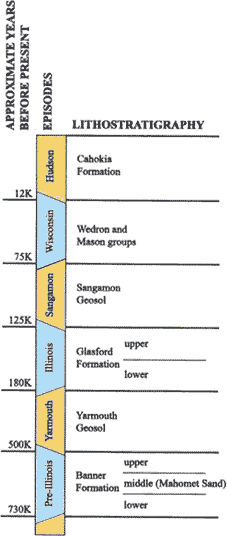3-D Geologic Mapping in East-Central Illinois



| GLACIAL EPISODES: Since approximately 730,000 years ago, glaciers advanced and retreated across the region. When glaciers advanced (during the "pre-Illinois", "Illinois", and "Wisconsin" episodes), they eroded the bedrock and older deposits, and deposited sediment. Most of the sediment was a poorly-sorted material (known as "till") composed of clay, silt, sand, gravel, and boulders. In places, however, water from the melting glaciers caused well-sorted sands and gravels to be deposited, much like in modern rivers. In time, these deposits were covered by till and, today they serve as groundwater aquifers. The most important one is the Mahomet Sand, of middle pre-Illinois age. INTERGLACIAL EPISODES: When the ice retreated (during the "Yarmouth", "Sangamon", and "Hudson" episodes), the climate grew warm, soils developed on the glacial deposits, and forests grew again. In some cases, these old soils are visible today, buried by glacial deposits. The soils that developed in glacial deposits tend to be rich and productive -- note, for example, the rich agricultural soils that occur today, on the recently-deposited Wisconsin-age glacial sediments. |